Strain-Mediated Magneto-Electric Effects in Coaxial Nanofibers of Y/W-Type Hexagonal Ferrites and Ferroelectrics
Abstract
:1. Introduction
2. Materials and Methods
2.1. Fabrication of Pure Hexagonal Ferrite Nanofibers
2.2. Preparation of Coaxial Nanofibers by Electrospinning
2.3. Characterization of Nanofibers
3. Results
3.1. Characterization of Y- and W-Type Hexagonal Ferrite Nanofibers
3.2. Structural Characterization of Core–Shell Composite Fibers
3.3. Ferroic Order Parameters for Core–Shell Composite Fibers
3.4. ME Characterization of Ferrite Core–Ferroelectric Shell Composite Fibers
3.5. ME Characterization of Ferroelectric Core–Ferrite Shell Composite Fibers
4. Discussions
5. Conclusions
Supplementary Materials
Author Contributions
Funding
Institutional Review Board Statement
Informed Consent Statement
Data Availability Statement
Conflicts of Interest
References
- Eerenstein, W.; Mathur, N.D.; Scott, J.F. Multiferroic and magnetoelectric materials. Nature 2006, 442, 759–765. [Google Scholar] [CrossRef]
- Spaldin, N.A.; Ramesh, R. Advances in magnetoelectric multiferroics. Nat. Mater. 2019, 18, 203–212. [Google Scholar] [CrossRef]
- Srinivasan, G. Magnetoelectric composites. Annu. Rev. Mater. Res. 2010, 40, 153–178. [Google Scholar] [CrossRef]
- Fiebig, M.; Lottermoser, T.; Meier, D.; Trassin, M. The evolution of multiferroics. Nat. Rev. Mater. 2016, 1, 1–14. [Google Scholar] [CrossRef]
- Srinivasan, G.; Priya, S.; Sun, N.X. Composite Magnetoelectrics: Materials, Structures, and Applications, 1st ed.; Woodhead Publishing: New York, NY, USA, 2015. [Google Scholar]
- Hu, J.; Li, Z.; Wang, J.; Nan, C.W. Electric-field control of strain-mediated magnetoelectric random access memory. J. Appl. Phys. 2010, 107, 9. [Google Scholar] [CrossRef]
- Chen, A.; Wen, Y.; Fang, B.; Zhao, Y.; Zhang, Q.; Chang, Y.; Li, P.; Wu, H.; Huang, H.; Lu, Y.; et al. Giant nonvolatile manipulation of magnetoresistance in magnetic tunnel junctions by electric fields via magnetoelectric coupling. Nat. Commun. 2019, 10, 243. [Google Scholar] [CrossRef]
- Leung, C.M.; Li, J.F.; Viehland, D.; Zhuang, X. A review on applications of magnetoelectric composites: From heterostructural uncooled magnetic sensors, energy harvesters to highly efficient power converters. J. Phys. D Appl. Phys. 2018, 51, 263002. [Google Scholar] [CrossRef]
- Fetisov, Y.; Srinivasan, G. Electric field tuning characteristics of a ferrite-piezoelectric microwave resonator. Appl. Phys. Lett. 2006, 88, 143503. [Google Scholar] [CrossRef]
- Ma, J.; Hu, J.; Li, Z.; Nan, C.W. Recent progress in multiferroic magnetoelectric composites: From bulk to thin films. Adv. Mater. 2011, 23, 1062–1087. [Google Scholar] [CrossRef]
- Ma, J.; Shi, Z.; Nan, C.W. Magnetoelectric properties of composites of single Pb(Zr,Ti)O3 rods and Terfenol-D/epoxy with a single-period of 1-3-type structure. Adv. Mater. 2007, 19, 2571–2573. [Google Scholar] [CrossRef]
- Gao, R.; Zhang, Q.; Xu, Z.; Wang, Z.; Cai, W.; Chen, G.; Deng, X.; Cao, X.; Luo, X.; Fu, C. Strong magnetoelectric coupling effect in BaTiO3@CoFe2O4 magnetoelectric multiferroic fluids. Nanoscale 2018, 10, 11750–11759. [Google Scholar] [CrossRef]
- Blachowicz, T.; Ehrmann, A. Most recent developments in electrospun magnetic nanofibers: A review. J. Eng. Fibers Fabr. 2020, 15, 1558925019900843. [Google Scholar] [CrossRef]
- Petrov, M.V.; Zhang, J.; Qu, H.; Zhou, P.; Zhang, T.; Srinivasan, G. Theory of magnetoelectric effects in multiferroic core–shell nanofibers of hexagonal ferrites and ferroelectrics. J. Phys. D Appl. Phys. 2018, 51, 284004. [Google Scholar] [CrossRef]
- Sreenivasulu, G.; Popov, M.; Zhang, R.; Sharma, K.; Janes, C.; Mukundan, A.; Srinivasan, G. Magnetic field assisted self-assembly of ferrite-ferroelectric core-shell nanofibers and studies on magneto-electric interactions. Appl. Phys. Lett. 2014, 104, 052910. [Google Scholar] [CrossRef]
- Liu, Y.; Zhou, P.; Fu, J.; Iyengar, M.; Liu, N.; Du, P.; Xiong, Y.; Moiseienko, V.; Zhang, W.; Zhang, J.; et al. Strain-mediated magneto-electric interactions in hexagonal ferrite and ferroelectric coaxial nanofibers. MRS Commun. 2020, 10, 230–241. [Google Scholar] [CrossRef]
- Viehland, D.; Li, J.F.; Yang, Y.; Costanzo, T.; Yourdkhani, A.; Caruntu, G.; Zhou, P.; Zhang, T.; Li, T.; Gupta, A.; et al. Tutorial: Product properties in multiferroic nanocomposites. J. Appl. Phys. 2018, 124, 061101. [Google Scholar] [CrossRef]
- Sreenivasulu, G.; Zhang, J.; Zhang, R.; Popov, M.; Petrov, V.; Srinivasan, G. Multiferroic core-shell nanofibers, assembly in a magnetic field, and studies on magneto-electric interactions. Materials 2018, 11, 18. [Google Scholar] [CrossRef] [Green Version]
- Smit, J.; Wijn, H.P.J. Ferrites; Phillips Technical Library: Eindhoven, The Netherlands, 1959. [Google Scholar]
- Kohn, J.A.; Eckart, D.W.; Cook, C.F. Crystallography of the hexagonal ferrites. Science 1971, 172, 519–525. [Google Scholar] [CrossRef] [PubMed]
- Pullar, R.C. Hexagonal ferrites: A review of the synthesis, properties and applications of hexaferrite ceramics. Prog. Mater. Sci. 2012, 57, 1191–1334. [Google Scholar] [CrossRef]
- Albanese, G.; Carbucicchio, M.; Asti, G. Spin-order and magnetic properties of BaZn2Fe16O27(Zn2-W) hexagonal ferrite. Appl. Phys. 1976, 11, 81–88. [Google Scholar] [CrossRef]
- Ustinov, A.B.; Srinivasan, G. Subterahertz excitations and magnetoelectric effects in hexaferrite-piezoelectric bilayers. Appl. Phys. Lett. 2008, 93, 142503. [Google Scholar] [CrossRef]
- Vopsaroiu, M.; Cain, M.G.; Sreenivasulu, G.; Srinivasan, G.; Balbashov, A.M. Multiferroic composite for combined detection of static and alternating magnetic fields. Mater. Lett. 2012, 66, 282–284. [Google Scholar] [CrossRef]
- Liu, Y.; Zhang, J.; Zhou, P.; Dong, C.; Liang, X.; Zhang, W.; Zhang, T.; Sun, N.X.; Filippov, D.; Srinivasan, G. Magneto-electric interactions in composites of self-biased Y-and W-type hexagonal ferrites and lead zirconate titanate: Experiment and theory. J. Appl. Phys. 2019, 126, 114102. [Google Scholar] [CrossRef]
- Pullar, R.C.; Bdikin, I.K.; Bhattacharya, A.K. Bhattacharya. Magnetic properties of randomly oriented BaM, SrM, Co2Y, Co2Z and Co2W hexagonal ferrite fibres. J. Eur. Ceram. Soc. 2012, 32, 905–913. [Google Scholar] [CrossRef]
- Li, C.-J.; Wang, B.; Wang, J.-N. Magnetic and microwave absorbing properties of electrospun Ba(1−x)LaxFe12O19 nanofibers. J. Magn. Magn. Mater. 2012, 324, 1305–1311. [Google Scholar] [CrossRef]
- Liu, G.F.; Zhang, Z.D.; Dang, F.; Cheng, C.B.; Hou, C.X. Formation and characterization of magnetic barium ferrite hollow fibers with low coercivity via co-electrospun. J. Magn. Magn. Mater. 2016, 412, 55–62. [Google Scholar] [CrossRef]
- Wei, Y.; Song, Y.; Deng, X.; Han, B.; Zhang, X.; Shen, Y.; Lin, Y. Dielectric and ferroelectric properties of BaTiO3 nanofibers prepared via electrospinning. J. Mater. Sci. Tech. 2014, 30, 743–747. [Google Scholar] [CrossRef]
- Cho, K.H.; Priya, S. Synthesis of ferroelectric PZT fibers using sol–gel technique. Mater. Lett. 2011, 65, 775–779. [Google Scholar] [CrossRef]
- Fan, M.; Hui, W.; Li, Z.; Shen, Z.; Li, H.; Jiang, A.; Chen, Y. Fabrication and piezoresponse of electrospun ultra-fine Pb(Zr0.3Ti0.7)O3 nanofibers. Microelectron. Eng. 1998, 98, 371. [Google Scholar] [CrossRef]
- Pullar, C.R.; Taylor, M.D.; Bhattacharya, A.K. Aligned hexagonal ferrite fibres of Co2W, BaCo2Fe16O27 produced from an aqueous sol–gel process. J. Mater. Sci. 1997, 32, 873–877. [Google Scholar] [CrossRef]
- Licci, F.; Rinaldi, S. Magnetostriction of some hexagonal ferrites. J. Appl. Phys. 1981, 52, 2442–2443. [Google Scholar] [CrossRef]
- Braden, A.R.; Gordon, I.; Harvey, R.L. Microwave properties of planar hexagonal ferrites. IEEE Trans. Magn. 1966, 2, 43–47. [Google Scholar] [CrossRef]
- Choopani, S.; Samavat, F.; Kolobova, E.N.; Grishin, A.M. Ferromagnetic resonance and magnetic anisotropy in biocompatible Y3Fe5O12@Na0.5K0.5NbO3 core-shell nanofibers. Ceram. Int. 2020, 46, 2072–2078. [Google Scholar] [CrossRef]
- Laletin, U.; Sreenivasulu, G.; Petrov, V.M.; Garg, T.; Kulkarni, A.R.; Venkataramani, N.; Srinivasan, G. Hysteresis and remanence in magnetoelectric effects in functionally graded magnetostrictive-piezoelectric layered composites. Phys. Rev. B 2012, 85, 104404. [Google Scholar] [CrossRef]
- Mandal, S.K.; Sreenivasulu, G.; Petrov, V.M.; Srinivasan, G. Magnetization-graded multiferroic composite and magnetoelectric effects at zero bias. Phys. Rev. B 2011, 84, 014432. [Google Scholar] [CrossRef]
- Sun, N.X.; Srinivasan, G. Voltage control of magnetism in multiferroic heterostructures and devices. In Spin; World Scientific Publishing Company: Bukit Batok, Singapore, 2012; Volume 2, p. 1240004. [Google Scholar]
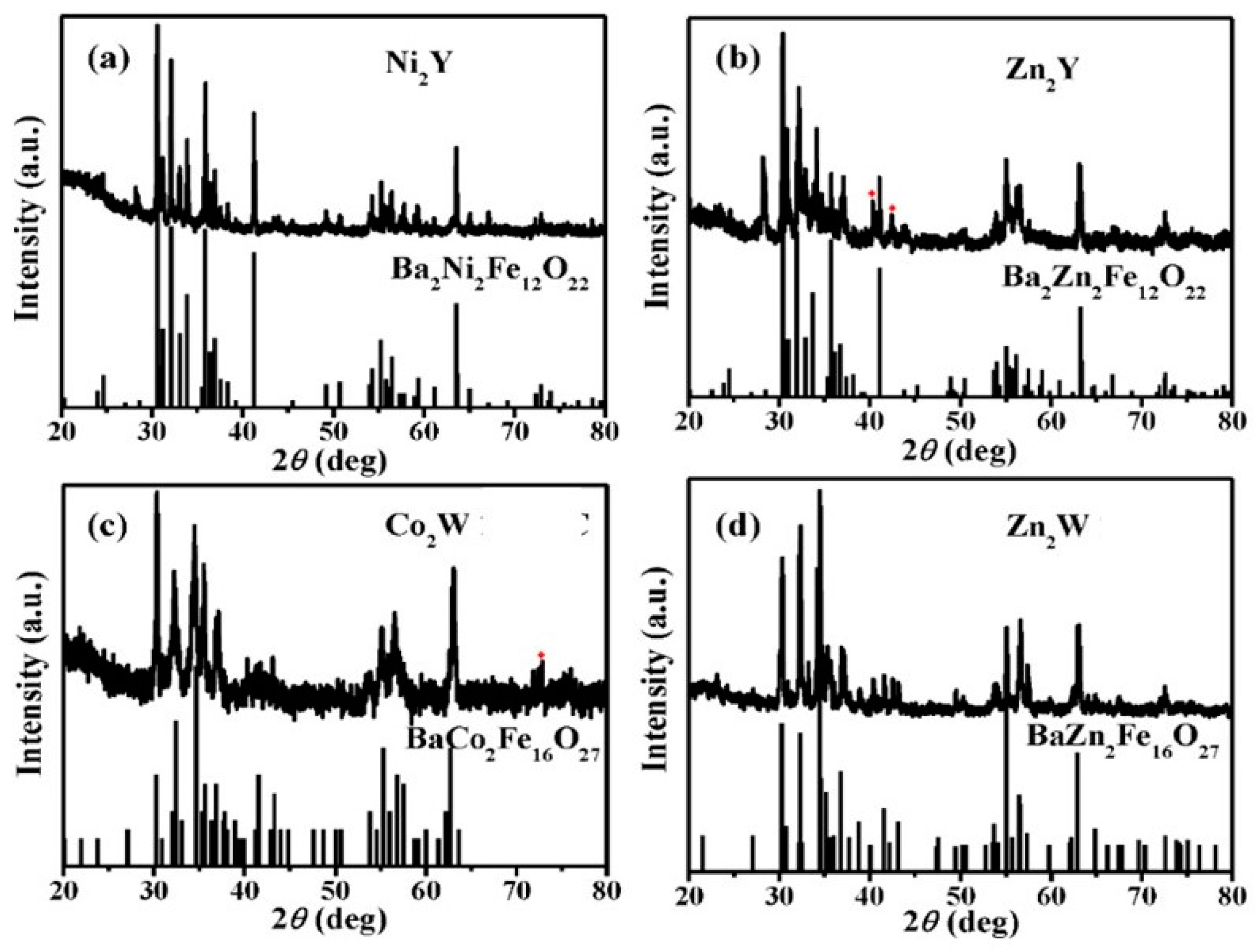

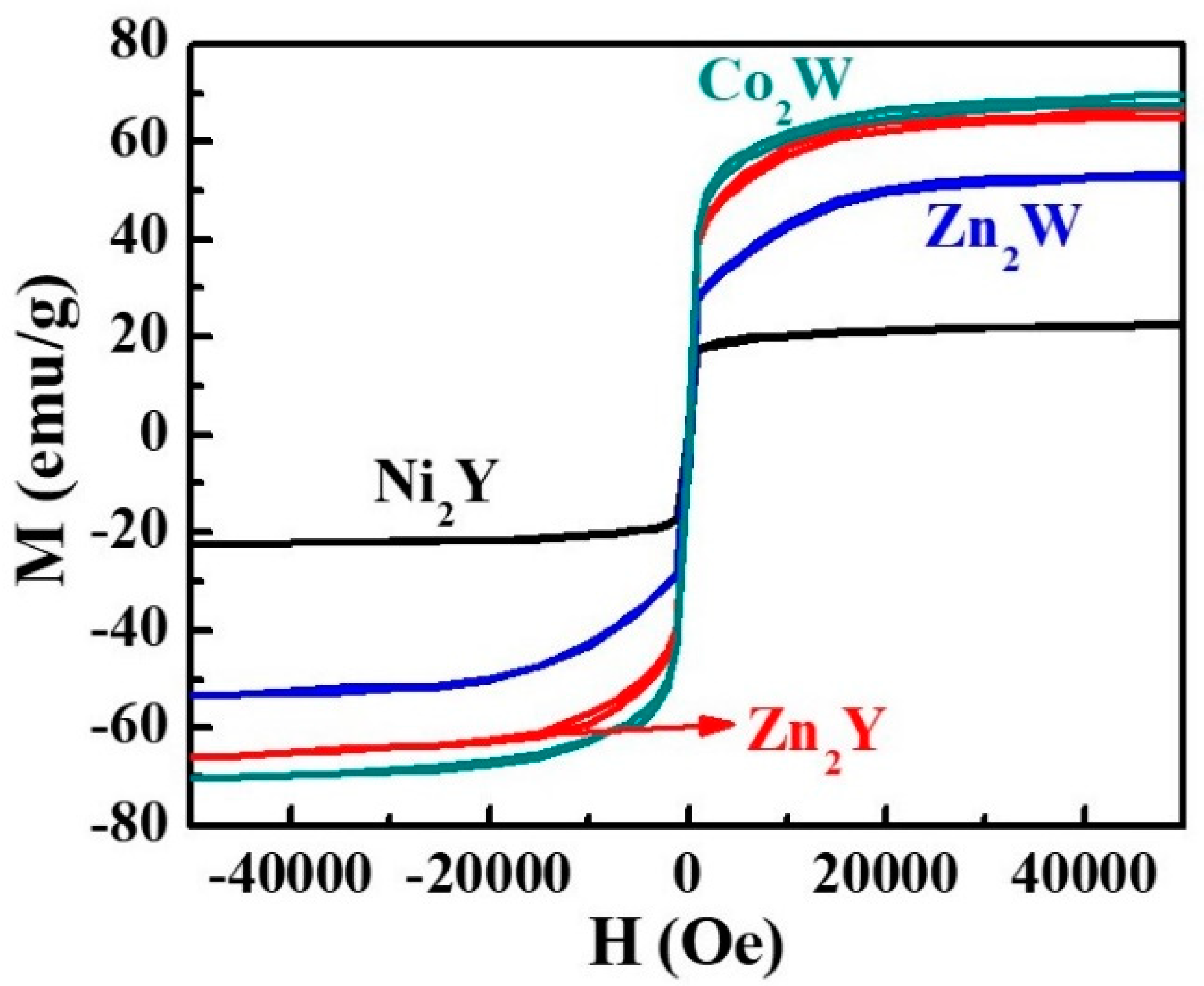
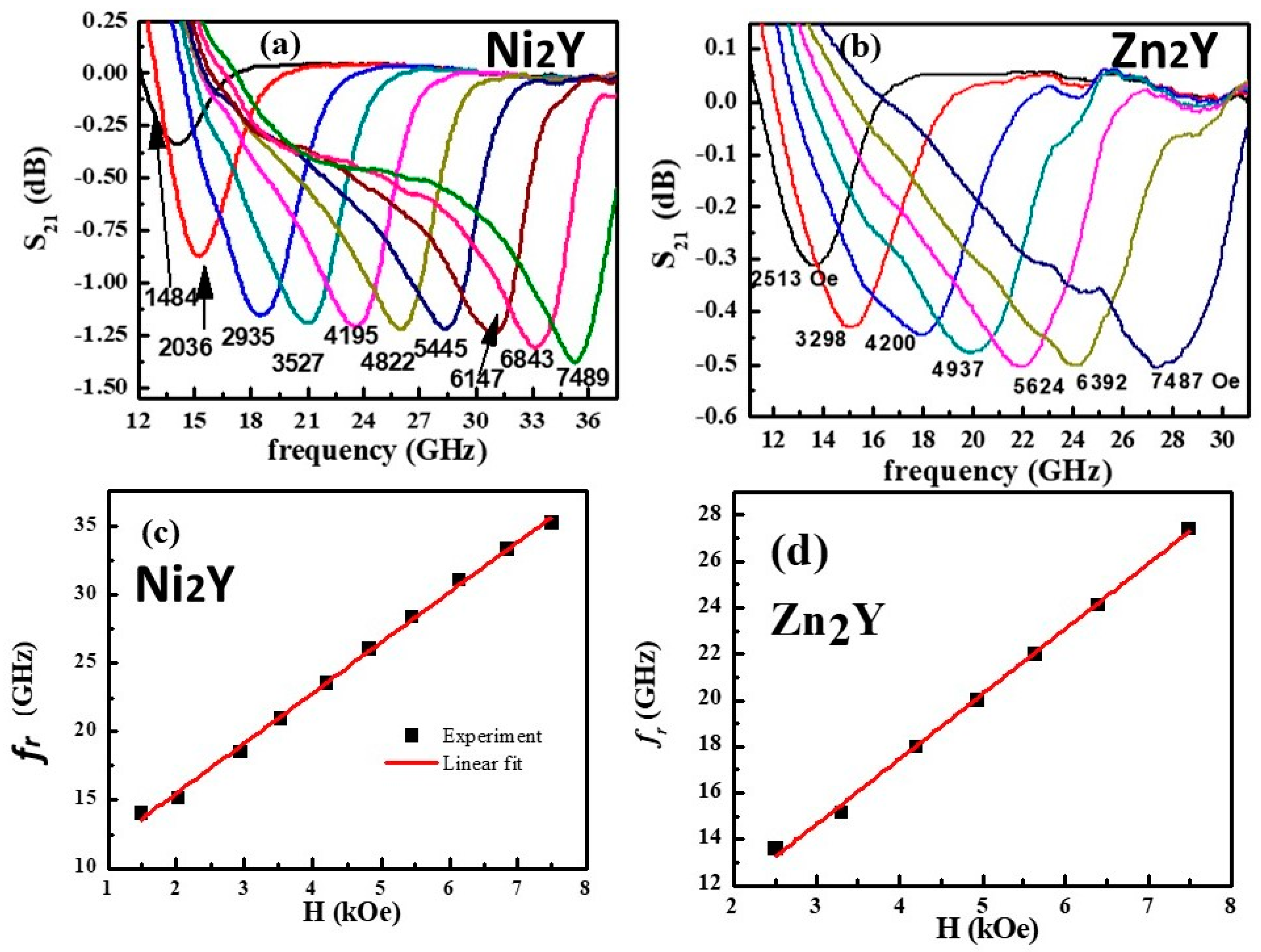

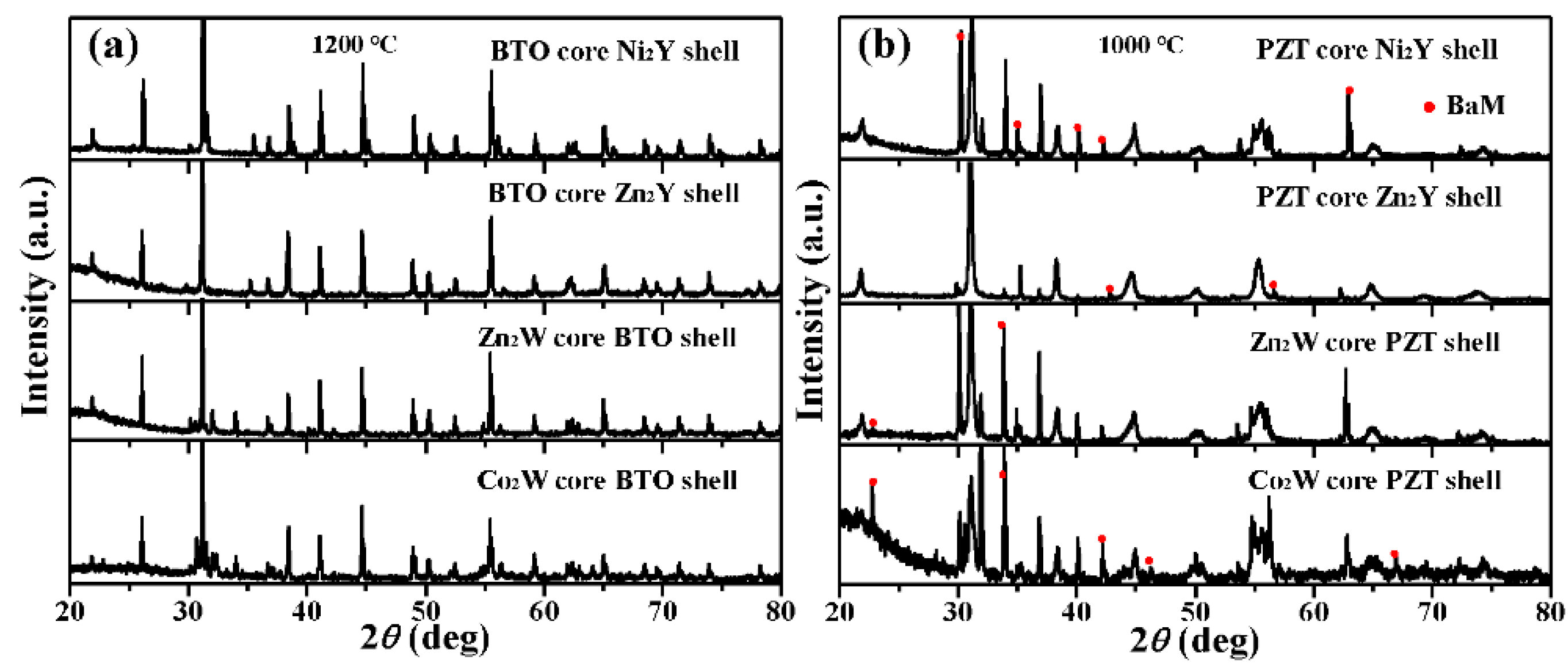


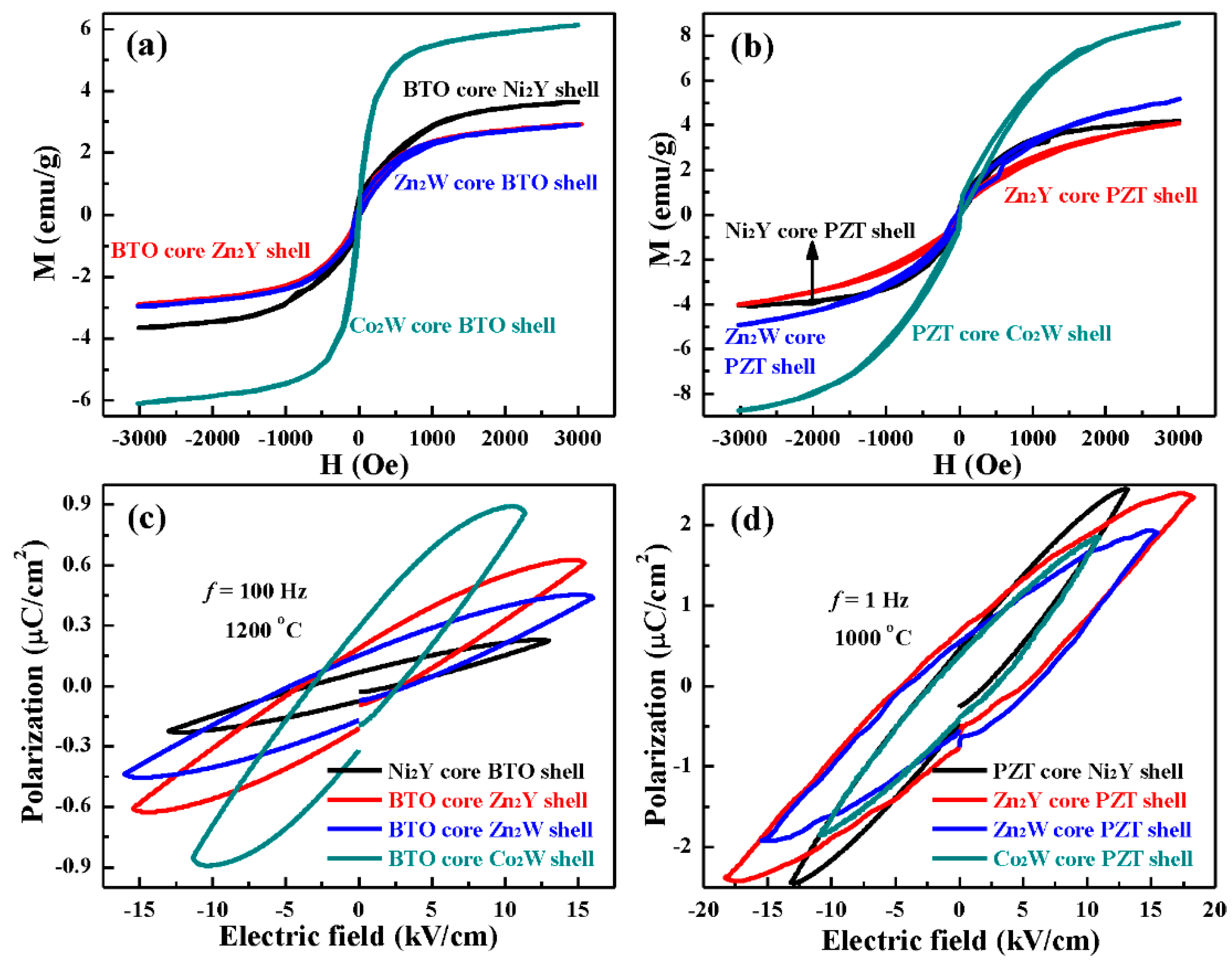
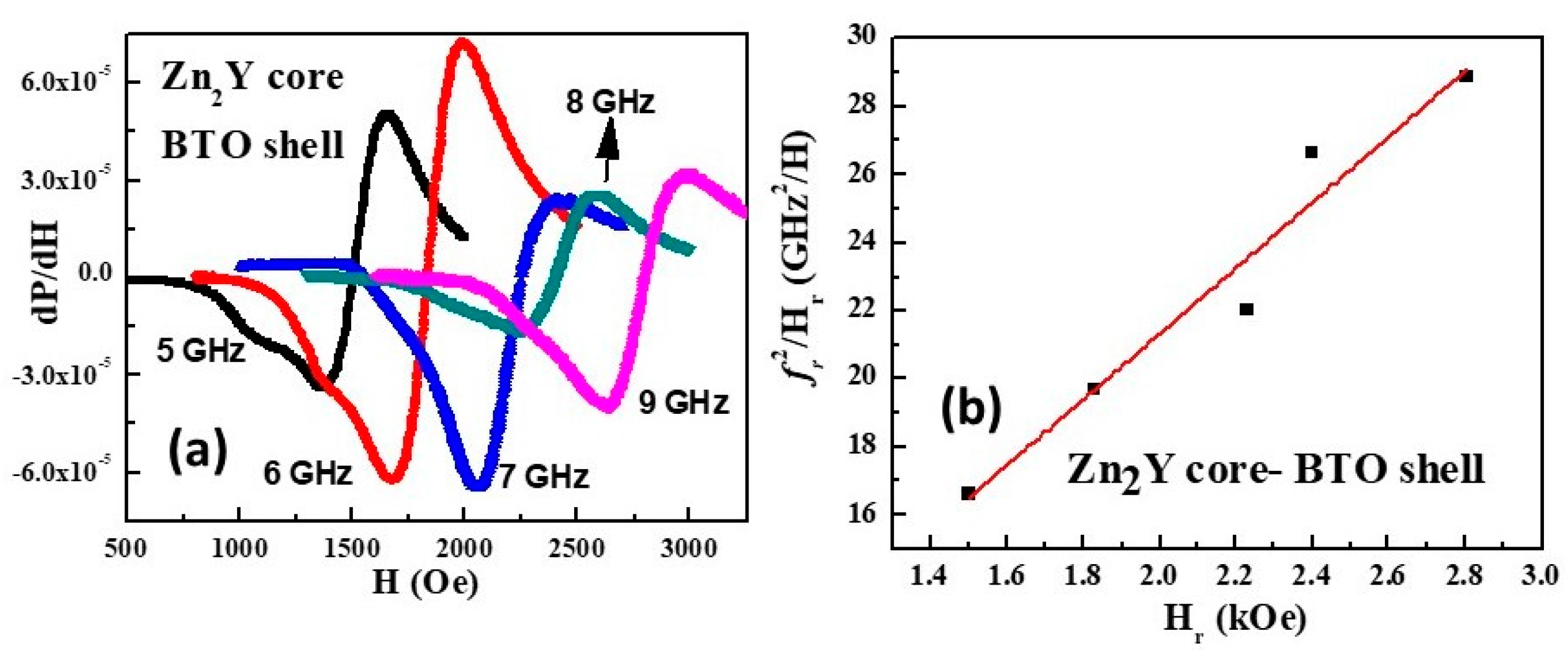
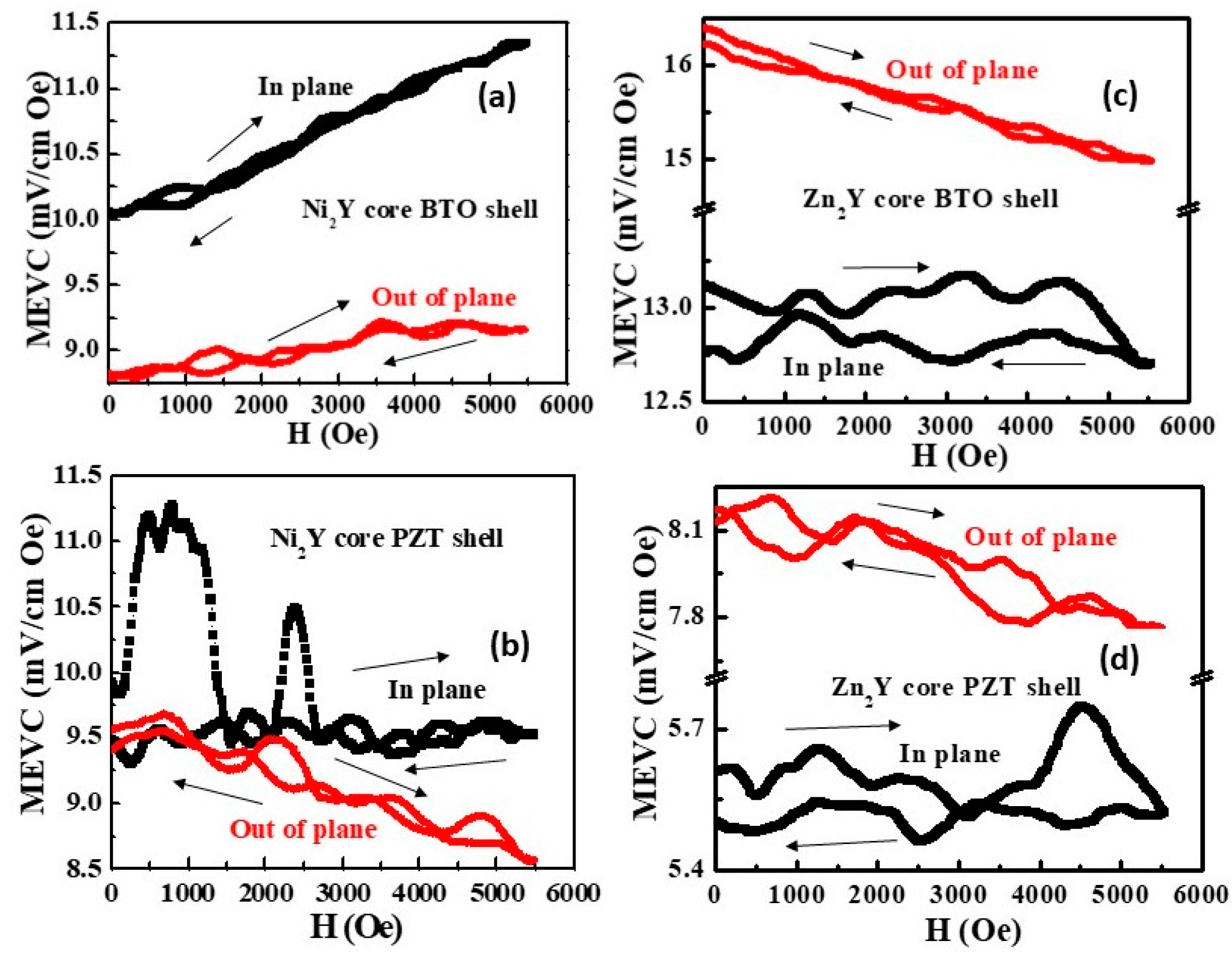
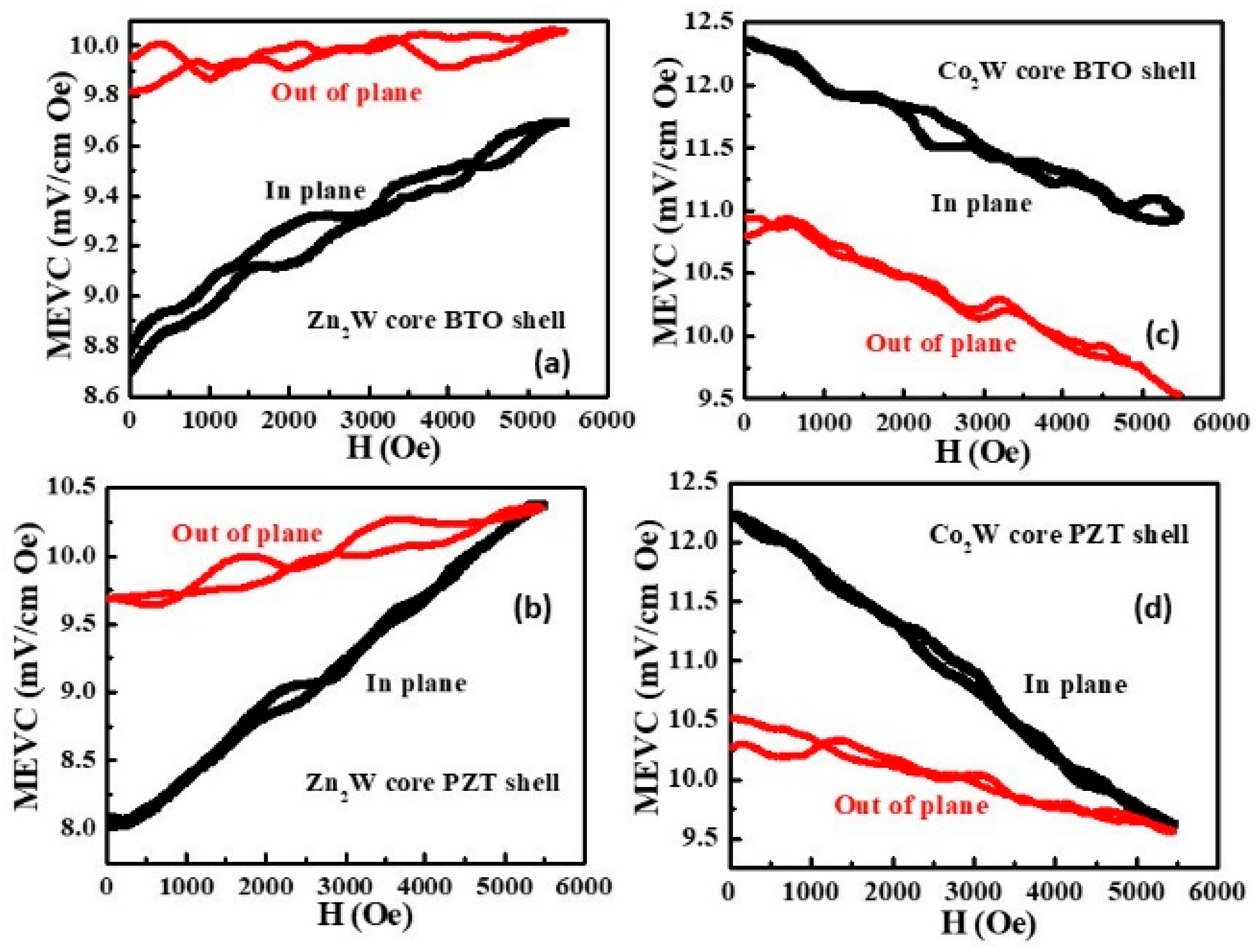


Publisher’s Note: MDPI stays neutral with regard to jurisdictional claims in published maps and institutional affiliations. |
© 2021 by the authors. Licensee MDPI, Basel, Switzerland. This article is an open access article distributed under the terms and conditions of the Creative Commons Attribution (CC BY) license (https://creativecommons.org/licenses/by/4.0/).
Share and Cite
Liu, Y.; Zhou, P.; Ge, B.; Liu, J.; Zhang, J.; Zhang, W.; Zhang, T.; Srinivasan, G. Strain-Mediated Magneto-Electric Effects in Coaxial Nanofibers of Y/W-Type Hexagonal Ferrites and Ferroelectrics. J. Compos. Sci. 2021, 5, 268. https://doi.org/10.3390/jcs5100268
Liu Y, Zhou P, Ge B, Liu J, Zhang J, Zhang W, Zhang T, Srinivasan G. Strain-Mediated Magneto-Electric Effects in Coaxial Nanofibers of Y/W-Type Hexagonal Ferrites and Ferroelectrics. Journal of Composites Science. 2021; 5(10):268. https://doi.org/10.3390/jcs5100268
Chicago/Turabian StyleLiu, Ying, Peng Zhou, Bingfeng Ge, Jiahui Liu, Jitao Zhang, Wei Zhang, Tianjing Zhang, and Gopalan Srinivasan. 2021. "Strain-Mediated Magneto-Electric Effects in Coaxial Nanofibers of Y/W-Type Hexagonal Ferrites and Ferroelectrics" Journal of Composites Science 5, no. 10: 268. https://doi.org/10.3390/jcs5100268
APA StyleLiu, Y., Zhou, P., Ge, B., Liu, J., Zhang, J., Zhang, W., Zhang, T., & Srinivasan, G. (2021). Strain-Mediated Magneto-Electric Effects in Coaxial Nanofibers of Y/W-Type Hexagonal Ferrites and Ferroelectrics. Journal of Composites Science, 5(10), 268. https://doi.org/10.3390/jcs5100268






